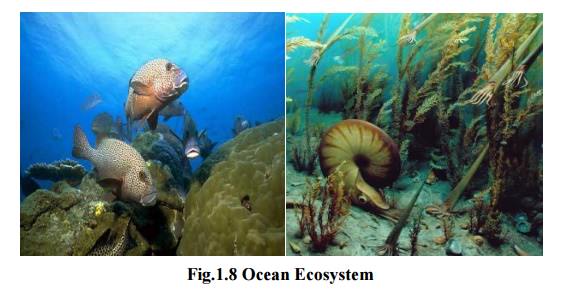Chapter: Environmental Science and Engineering
Aquatic ecosystems
AQUATIC ECOSYSTEMS
Introduction
v Aquatic
ecosystems deal with biotic community present in water bodies.
v In terrestrial
ecosystem, carbon dioxide & oxygen are present in gaseous form whereas in
aquatic ecosystem, these are available in dissolved state.
v Depending
upon the quality and nature of water, the aquatic ecosystem are categorized
into:
v Freshwater
Ecosystem and
v Marine
Ecosystem.
Freshwater Ecosystems
v Freshwater
ecosystems cover 0.8% of the Earth's surface and contain 0.009% of its total
water.
v Freshwater
ecosystems contain 41% of the world's known fish species.
v Aquatic
ecosystems perform many important environmental functions. For example:
Ø They
recycle nutrients, purify water, attenuate floods, recharge ground water and
provide habitats for wildlife.
Ø Aquatic
ecosystems are also used for human recreation, and are very important to the
tourism industry, especially in coastal region.
v There are
three basic types of freshwater ecosystems:
q Lentic:
slow-moving water, including Pools, Ponds, and Lakes.
q Lotic:
rapidly-moving water, for example Streams and Rivers.
q Wetlands:
areas where the soil is saturated with water or inundated for at least part of
the time
Lakes & pond Ecosystem
v A pond is
a place where living organisms not only live but interact with biotic &
abiotic components.
v Ponds are
often exposed to tremendous anthropogenic pressure which significantly affects
the system.
v Lakes are
usually big standing freshwater bodies.
v They have
a shallow water zone called Littoral zone; an open water zone where effective
penetration of solar light takes place, called limnetic zone and a deep water
zone where light penetration is negligible, called Profoundal zone.
I. Biotic components
1) Producer Organisms
v It
includes submerged, free floating and amphibious macrophytes (like; Hydrilla,
Utricularia, Wolfia, Azolla, Typha etc.) and minute floating and suspended lower
phytoplanktons (like; Ulothrix, Spirogyra, Oedogonium etc.)
2) Consumer Organisms
a) Primary
consumers:These are zooplanktons (ciliates, flagellates, other protozoan, small
crustaceans) and benthos.
b) Secondary
consumers: These are carnivores like insects and fishes feeding on herbivores
c) Tertiary
consumers: These are the large fishes feeding on small fishes.
3) Decomposers Micro – organisms like
bacteria, fungi and actinomyctes.
II. Abiotic component
v These are
the inorganic as well as organic substances present in the bottom soil or
dissolved in water. In addition, to the minerals, some dead organic matter is
also present.

Marine or Ocean Ecosystem
v Marine
ecosystems are among the Earth's aquatic ecosystems. They include: Oceans,
Estuaries and Lagoons, Mangroves and Coral reefs, the Deep sea and the Sea
floor.
v These are
the gigantic reservoirs of water covering approximately 71% of the Earth's
surface (an area of some 361 million square kilometers).
v These
ecosystems are different from freshwater ecosystem mainly because of its salty
water.
v The salt
concentration in an open sea is usually 3.5% (35 parts per thousand (ppt)).
Dominant ions are sodium & chloride.
v Average
temperature of Marine ecosystem is 2-3 degree centigrade, devoid of light.
I. Biotic components
1) Producers It includes phytoplanktons
(diatoms, dinoflagillates), large seaweeds (mainly algae like chlorophyceae, phaeophyceae &
rhodophyceae; angiosperms like Ruppia, Zostera, posidonia ), and mangrove
vegetation (like Rhizophora, Carapa etc.)
2) Consumers
a) Primary
consumers: These are herbivores and feed directly on producers (Crustaceans,
Mollusks, fish etc.)
b) Secondary
consumers: These are carnivorous fishes (Herring, Sahd and Mackerel)
c) Tertiary
consumers: These are top carnivorous fishes (Cod, Haddock, etc.)
3) Decomposers These are micro –
organisms like bacteria, fungi
II. Abiotic components
v High Na,
Ca, Mg and K salt concentration, variable dissolved oxygen content, light &
temperature make a unique physiochemical conditions in marine water.

Related Topics